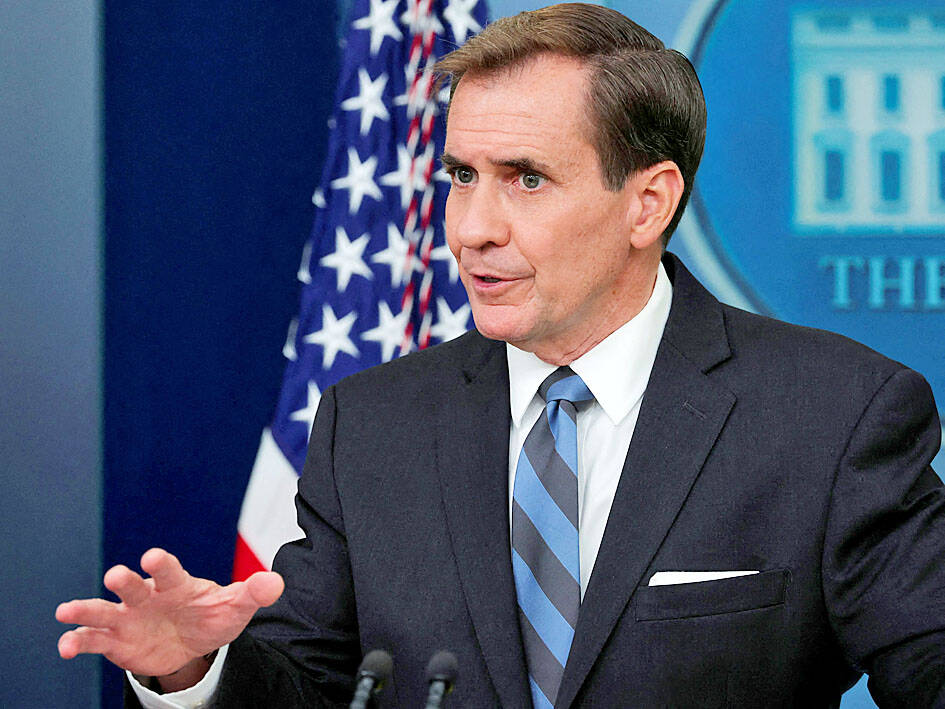“There is no reason” for a conflict in the Taiwan Strait, US National Security Council spokesman John Kirby said on Thursday, just days after a Pentagon official said that China could be militarily capable of attacking Taiwan before 2024.
At a White House news briefing, Kirby declined to comment on remarks by US Chief of Naval Operations Admiral Michael Gilday at a think tank event on Wednesday.
“I would just say, look, we monitor this, monitor this as best we can, and I’m not going to get into intelligence assessments one way or the other,” Kirby said.

Photo: Reuters
“There is no reason for this to erupt into conflict,” Kirby said, referring to tensions across the Taiwan Strait.
Kirby said the US does not want to see any unilateral change to the “status quo” across the Strait by force.
“There’s absolutely no reason for that to happen since there’s been no change in the way we’re approaching Taiwan and Taiwan’s self-defense,” he said.
Kirby also declined to confirm reports of talks between Taiwan and the US about joint production of weapons between the two countries, saying he does not “have anything specific on that.”
Kirby reiterated the US commitment to help Taiwan defend itself, saying that “we’re always going to be open to considering new ways to do that in concert with Taiwan.”
At a talk hosted by the Atlantic Council on Wednesday, Gilday said the Chinese military could be capable of invading Taiwan by the end of this year or some time next year.
“When we talk about the 2027 window, in my mind, that has to be a 2022 window or potentially a 2023 window,” Gilday said. “I can’t rule it out. I don’t mean at all to be alarmist... We can’t wish that away.”
He said his assessment is based on statements by Chinese President Xi Jinping (習近平) and “how the Chinese behave and what they do.”
“What we’ve seen over the past 20 years is that they have delivered on every promise they’ve made earlier than they said,” Gilday said.
The so-called 2027 window was first put forward by then-US Indo-Pacific Command commander admiral Phil Davidson, who said during congressional testimony last year that the threat of a Chinese attack on Taiwan could “manifest ... in the next six years.”
Meanwhile, US Department of Defense press secretary General Patrick Ryder declined to comment on whether the Pentagon had reassessed or updated the 2027 assessment.
“I don’t have any new updates to provide,” Ryder told a news briefing on Thursday.
“China continues to be the pacing challenge” and the US is concerned about “their coercive and provocative behavior” in the Indo-Pacific region, Ryder said.
“Our focus is on working with allies and partners in that region to ensure that the Indo-Pacific remains free and open and secure and stable,” he said. “We would call on all parties to do the same.”
Ryder said the US would continue to abide by its “one China” policy and to support Taiwan to maintain its self-defense capabilities, as defined in the US’ Taiwan Relations Act.
Separately, US Secretary of State Antony Blinken said in a television interview that China had long ago decided to speed up unification “potentially by any means.”
Blinken was asked about his statement on Monday that Beijing plans to annex Taiwan on a “much faster timeline” under Xi.
There was once an understanding that cross-strait differences would be resolved peacefully, but Beijing made a decision “some years ago that that was no longer acceptable and that the government wanted to speed up reunification,” Blinken said.
This could happen “through coercion and pressure, and potentially, if necessary, by force,” he said, adding that the US remains committed to ensuring that Taiwan has the ability to effectively defend itself.
Additional reporting by staff writer

SECURITY: As China is ‘reshaping’ Hong Kong’s population, Taiwan must raise the eligibility threshold for applications from Hong Kongers, Chiu Chui-cheng said When Hong Kong and Macau citizens apply for residency in Taiwan, it would be under a new category that includes a “national security observation period,” Mainland Affairs Council (MAC) Minister Chiu Chui-cheng (邱垂正) said yesterday. President William Lai (賴清德) on March 13 announced 17 strategies to counter China’s aggression toward Taiwan, including incorporating national security considerations into the review process for residency applications from Hong Kong and Macau citizens. The situation in Hong Kong is constantly changing, Chiu said to media yesterday on the sidelines of the Taipei Technology Run hosted by the Taipei Neihu Technology Park Development Association. With

CARROT AND STICK: While unrelenting in its military threats, China attracted nearly 40,000 Taiwanese to over 400 business events last year Nearly 40,000 Taiwanese last year joined industry events in China, such as conferences and trade fairs, supported by the Chinese government, a study showed yesterday, as Beijing ramps up a charm offensive toward Taipei alongside military pressure. China has long taken a carrot-and-stick approach to Taiwan, threatening it with the prospect of military action while reaching out to those it believes are amenable to Beijing’s point of view. Taiwanese security officials are wary of what they see as Beijing’s influence campaigns to sway public opinion after Taipei and Beijing gradually resumed travel links halted by the COVID-19 pandemic, but the scale of

A US Marine Corps regiment equipped with Naval Strike Missiles (NSM) is set to participate in the upcoming Balikatan 25 exercise in the Luzon Strait, marking the system’s first-ever deployment in the Philippines. US and Philippine officials have separately confirmed that the Navy Marine Expeditionary Ship Interdiction System (NMESIS) — the mobile launch platform for the Naval Strike Missile — would take part in the joint exercise. The missiles are being deployed to “a strategic first island chain chokepoint” in the waters between Taiwan proper and the Philippines, US-based Naval News reported. “The Luzon Strait and Bashi Channel represent a critical access

Pope Francis is be laid to rest on Saturday after lying in state for three days in St Peter’s Basilica, where the faithful are expected to flock to pay their respects to history’s first Latin American pontiff. The cardinals met yesterday in the Vatican’s synod hall to chart the next steps before a conclave begins to choose Francis’ successor, as condolences poured in from around the world. According to current norms, the conclave must begin between May 5 and 10. The cardinals set the funeral for Saturday at 10am in St Peter’s Square, to be celebrated by the dean of the College